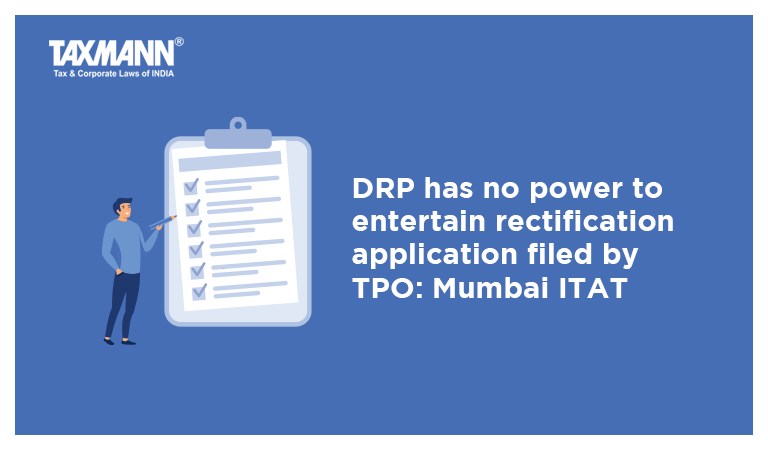DRP has no power to entertain rectification application filed by TPO: Mumbai ITAT
- Blog|News|Transfer Pricing|
- 2 Min Read
- By Taxmann
- |
- Last Updated on 30 June, 2022

Case Details: Shapoorji Pallonji Bumi Armada (P.) Ltd. v. ACIT - [2022] 139 taxmann.com 572 (Mumbai-Trib.)
Judiciary and Counsel Details
-
- Pramod Kumar, Vice-President & Sandeep S. Karhail, Judicial Member
- Mukesh Butani, Karishma Phatarphkar, Pratik Poddar & Rohan Vasuna for the Appellant.
- Vatsala Jha for the Respondent.
Facts of the Case
The core issue before the Mumbai Tribunal was:
“Whether the Dispute Resolution Panel was justified in passing rectification order on application made by the Transfer Pricing Officer?”
ITAT Held
The Mumbai Tribunal held that Section 144C(14) empowers the Central Board of Direct Taxes (CBDT) to make rules for the purposes of the efficient functioning of the Dispute Resolution Panel (DRP) and expeditious disposal of the objections filed by the eligible assessee.
In exercise of these powers, the CBDT had notified the Income-tax (Dispute Resolution Panel) Rules, 2009. Rule 13 said rules make clear that rectification powers by the DRP can be exercised only in one of the three circumstances:
a) Suo motu, i.e. on its own by the DRP;
b) On an application made by the eligible assessee; or
c) On an application made by the Assessing Officer.
The scheme of Rule 13 does not visualize any rectification of mistake, by the DRP, on an application by the Transfer Pricing Officer (TPO). Thus, the application filed by the TPO before the Dispute Resolution Panel, irrespective of its nomenclature, was liable to be dismissed.
Further, as per the rectification application, TPO sought the rectification by contending that there are various mistakes apparent on record in the order of the learned DRP which are being delineated.
In any event, the rectification of mistakes, as permitted under rule 13, is only with respect to “mistake or error is apparent in DRP direction. That is precisely what Section 154 also covers since it covers “mistake apparent from the record”, the connotations of a mistake ‘apparent in such direction’ cannot be any broader than the connotations of a mistake ‘apparent from the record’.
Thus, the DRP can neither embark upon a review of its own order nor tinker with the areas beyond the mistake apparent on the record which is “an obvious and patent mistake and not something which can be established by a long-drawn process of reasoning on points on which there may conceivably be two opinions”.
Disclaimer: The content/information published on the website is only for general information of the user and shall not be construed as legal advice. While the Taxmann has exercised reasonable efforts to ensure the veracity of information/content published, Taxmann shall be under no liability in any manner whatsoever for incorrect information, if any.

Taxmann Publications has a dedicated in-house Research & Editorial Team. This team consists of a team of Chartered Accountants, Company Secretaries, and Lawyers. This team works under the guidance and supervision of editor-in-chief Mr Rakesh Bhargava.
The Research and Editorial Team is responsible for developing reliable and accurate content for the readers. The team follows the six-sigma approach to achieve the benchmark of zero error in its publications and research platforms. The team ensures that the following publication guidelines are thoroughly followed while developing the content:
- The statutory material is obtained only from the authorized and reliable sources
- All the latest developments in the judicial and legislative fields are covered
- Prepare the analytical write-ups on current, controversial, and important issues to help the readers to understand the concept and its implications
- Every content published by Taxmann is complete, accurate and lucid
- All evidence-based statements are supported with proper reference to Section, Circular No., Notification No. or citations
- The golden rules of grammar, style and consistency are thoroughly followed
- Font and size that’s easy to read and remain consistent across all imprint and digital publications are applied





